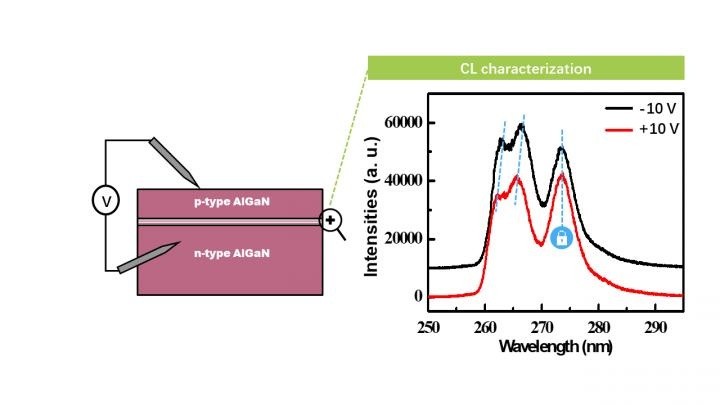Jul 13 2020
Deep ultraviolet, also known as DUV, optoelectronic devices of less than 280 nm are extensively used in sterilization, medical treatment, environmental protection, high-density information storage, and other fields.
 Applying an external electric field on the quantum well, the emission peak related to the CH band at the VBM barely shift, which is no match to the behaviors of the quantum level dependent on the electric fields. Image Credit: Li Chen, Wei Lin, Huiqiong Wang, Jinchai Li, and Junyong Kang.
Applying an external electric field on the quantum well, the emission peak related to the CH band at the VBM barely shift, which is no match to the behaviors of the quantum level dependent on the electric fields. Image Credit: Li Chen, Wei Lin, Huiqiong Wang, Jinchai Li, and Junyong Kang.
The outbreak of a novel coronavirus is threatening the lives of more than 10 million individuals across the world. Therefore, the development and analysis of a new range of optoelectronic devices and semiconductor materials with wavelengths in the DUV range have turned out to be more and more attractive for both industry and academia around the world.
AlGaN is a wide-bandgap semiconductor that covers the UVA, UVB, and UVC range with interesting characteristics—such as saturation velocity, breakdown field, high peak electron velocity, and thermal stability—that make it possible to operate a device below the visible spectrum range that is appropriate for solid-state DUV emitters.
In spite of their familiar potential applications, AlGaN optical devices doped with Al are still prone to restricted efficiency. In the earlier analysis, it was seen that an abnormal behavior was exhibited by the primary radiative emission at the band edge in the case of high-Al-content AlGaN quantum well (QW) on the c-plane. This behavior is not the same as the other emission that is susceptible to the external electric fields, as depicted in the above image.
It is usually assumed that compared to a higher quantum level, the lowest quantum level can provide a more improved confinement. In high-Al-content AlGaN, the valence band maximum (VBM) is a dispersive crystal field split-off hole band (CH band) containing pz orbital, and therefore, the unusual quantum confinement turns out to be a major restriction for efficient DUV emission.
Due to the special band structure as well as orbital configuration, the characteristics of radiative transition in quantum structure are highly associated with pz orbital. Apart from the band-offset, the induced energy gain that occurs in the confinement direction should also be considered. Such limited interpretation of orbital coupling mechanism in quantum tends to limit direction, thus hindering the improvement of high-Al-content AlGaN optoelectronic devices.
To figure out the fundamental mechanism of orbital intercoupling on the basis of the quantum confinement direction, high-Al-content AlGaN QW models were built and analyzed using first-principle simulations.
The analysis of the band structure revealed that valence band contains p orbitals. These p orbitals that overlap in a head-over-head manner form ppσ coupling with positive energy gain, whereas p orbitals that overlap with each other in a side-by-side manner cause coupling between ppπ and negative energy variation.
In the case of the c-plane polar AlGaN QW, the ppσ coupling mainly contributes the compensation of CH band potential barrier at VBM. But with regard to the HH/LH band, the barrier is improved by the ppπ coupling.
The carrier distribution as well as the orbital projected density of states at VBM along the direction of confinement shows that the potential barrier is lowered by the dominant ppσ coupling of the pz state, causing the delocalization of the pz orbital. The scenario is reversed on the ppπ coupling that the px orbital exhibits a higher barrier for quantum confinement to limit the carriers in the quantum well.
Considering the link between the confinement direction and the orbital coupling, the incline quantum well plane recommended orbital engineering to alter the energy changes caused by the orbital coupling. Quantum well models—Al0.75Ga0.25N and AlN—were built using the well plane inclined from 0° to 90° at a step of 30° called the c plane.
The inclination angle of 60° and 30° relate to the (10¯11) and (10¯13)—two 90° models of (10¯10) and (11¯20) plane nonpolar quantum well.
When the inclination angles are increased, the ppπ component increases, while the ppσ component decreases. At VBM, the distribution of p states additionally proves the improvement of quantum confinement with the increased rate of radiative transition at the band edge. At the experiment level, varying facets of the hexagonal microrods with pyramid-shaped tops were used to grow the quantum well.
In accordance with cathodoluminescence (CL) spectra and scanning electron microscope, even the characterization is considered from the peak of the pyramid, that is, the emission from the quantum well on the nonpolar plane is stronger when compared to that on the polar plane and the semipolar plane, demonstrating the viability of the orbital engineering.
In the present analysis, the research effort has provided proof that the orbital intercoupling has a crucial role to play, particularly in materials that have powerful polarization. Within the quantum structure, the valence p orbitals are susceptible to the confinement direction, which negatively impacts the symmetry of the rectangular well potential.
Therefore, awareness of the orbital intercoupling as well as its effect on the well potential offers a new outlook on the construction of superlattices and heterostructures.
The literature states that charge-transfer compounds exhibit high-temperature superconductivity that is defined by powerful hybridization between transition metal 3d and oxygen 2p states and with intricate electronic configurations, providing clues for the active presence of the orbital coupling.
It is natural to anticipate that orbital engineering is not simply restricted to AlGaN but can also be extended to other applications in new semiconductor material and structure having special functional characteristics.
Journal Reference:
Chen, L., et al. (2020) Reversing abnormal hole localization in high-Al-content AlGaN quantum well to enhance deep ultraviolet emission by regulating the orbital state coupling. Light: Science & Application. doi.org/10.1038/s41377-020-00342-3.